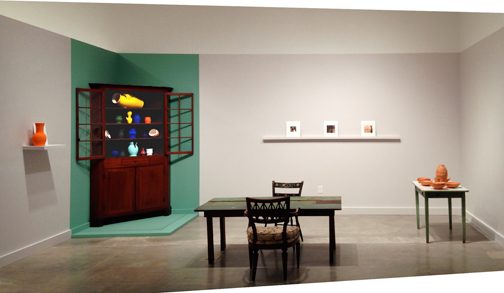Zuckerman Museum
HEARSAY / Solo Project
Co-curated by Teresa Reeves, Kirstie Tepper, and Julia Brock
CAROLYN CARR
STILL LIFE
Exhibition Dates July 26 - October 25, 2014
Notes on Still Life
"There must surely be as many ways of seeing a place as there are pairs of eyes to see it."
– Eudora Welty
Still Life invites its viewers to enter a multi-dimensional landscape that is both domestic and otherworldly. In this solo installation by artist Carolyn Carr, found and created objects occupy the space. Brightly colored vessels made by Carr are positioned in an early American cupboard. Lined in a single row, the artists’s silver gelatin photographs document the landscape from whence the clay originated. A shelf with a photograph and a vessel, a kitchen table with Carr’s unglazed earthen ware, and a writing table with sketchbooks and a cassette recorder complete the scenic space. Through these final elements—the sketchbook and recorder—Carr invites viewer/participants to share their responses and impressions. Thus, with Still Life, Carr creates a shared stage for maker and viewer to co-create the “story” of the work.
The essays of French theorist/philosopher Roland Barthes encourage us to embrace the evolution of art and literature from the work—which contains one objective meaning for a reader to decipher—to the Text, which celebrates subjectivity, plurality, and open fields of meanings. Barthes asserts, “In the multiplicity of writing, everything is to be disentangled, nothing deciphered; the structure can be followed…but there is nothing beneath.”2 In Still Life the authorial eye is evident through the arrangement of scenic elements and the framing of the Southern landscapes represented in the photographs. Like language (and Barthes’ mercurial Text), the objects and images in Still Life are “structured but off-centred, without closure.”3 Carr’s presence as Author/Maker recedes when she bids us to step onto the stage, construct our own narratives about meanings, and inscribe themin a sketch book at the periphery of the space. Our reading becomes performative: when we sit at the table and handwrite/draw or record our reflections, we play as co-authors of a living, changing text-between-texts.
The larger setting for the installation—the Zuckerman Museum of Art on the campus of Kennesaw State University —provides a fitting stage for this performative co-authorship. Students, faculty, artists, and community members perform as equal “guests” and players of meanings in Still Life. Each contributes his or her unique point of view to the evolving Text. At the same time, we are challenged to re-frame our viewpoints and question our habits of seeing. All landscapes are complex. All stories are fictions. We discover, in the words of southern writer Eudora Welty, “that point of view is hardly a simple, unalterable vision, but a profound and developing one of great complexity.”4 Still Life celebrates this complexity and invites us to play with and around the fields of meanings in the landscapes of our lives.
Margaret Baldwin Pendergrass
Playwright and Senior Lecturers, Department of Theatre and Performance Studies
Kennesaw State University
1 Eudora Welty, “Place in Fiction,” in The Eye of the Story (New York: Vintage Books, 2010), 130.
2 Roland Barthes, “The Death of the Author,” in Image-Music-Text, trans. Stephen Heath (New York: Hill and Wang, 1977).
3 Roland Barthes, “From Work to Text,” in Image-Music-Text, trans. Stephen Heath (New York: Hill and Wang, 1977), 159.
4 Eudora Welty, “Place in Fiction,” in The Eye of the Story (New York: Vintage Books, 2010), 132.
Hearsay
July 26 - October 25, 2014
Hearsay is a series of solo projects that seek to revise and expand on traditional independent narratives and visualizations. Embedded in this effort is the desire to privilege a form of knowledge often dismissed or ignored by traditional scholarship. Allowing for hearsay, which includes the possibility of speculations, rumor, gossip, and unsubstantiated claims, gives life to alternative realities and offers potentially liberatory visualizations of what could have been or might be. In these projects, subjectivity is embraced and mobility and change are understood as an underlying characteristic of escape and flights of imaginations. Co-curated by Teresa Reeves, Kirstie Tepper, and Julia Brock.

